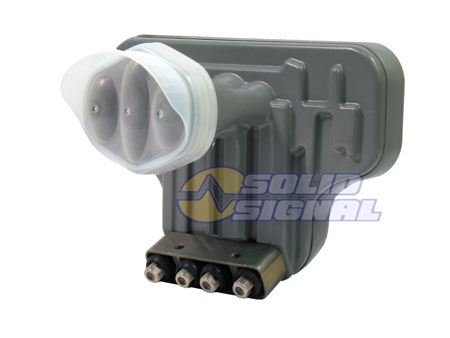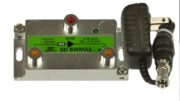What you see above you is an LNB. It’s the front part of a satellite dish. It’s not very big… really not much bigger than a closed fist. Now, imagine how small a satellite antenna could be if you didn’t need that big reflector on the back! All you’d need is that LNB.
But… ya do.
The reflector is a critical part of a satellite system. It acts like a lens that focuses signal onto one point. Here’s a very simple drawing that shows how a reflector works:

See how the signals come in and then bounce off the curved surface. They then focus all on one point. The LNB itself actually receives the signals, but thanks to the reflector it’s as if you had an LNB that as about 600 times larger than it is.
But why do you need so much signal?
The fact is that satellite signals are very, very, very weak. They start out 22,000 miles away and even though they’re fairly strong at that point, they get weaker as they travel. That’s called the “rule of squares.” Then, the signals travel through air which makes them even weaker and in some cases clouds which weakens them further.
By the time those signals get to your home they’re measured in 10-millionths of a watt. Believe it or not they are still there, still usable, but they need a lot of help.
The first step is to collect as much signal as possible. The reflector makes that happen.
But what would happen if you didn’t have a reflector?
Without a reflector, you have nothing. The signal getting to the LNB would be so weak that the LNB, as sensitive as it is, wouldn’t pick up anything.
It’s been suggested that you could combine two or more LNBs to get the same effect without the reflector. As I said, though, the math doesn’t add up. You’d need about 600 LNBs, all perfectly calibrated, individually aimed, and precisely combined. This would be almost impossible to maintain. It would also be, realistically, incredibly expensive.
So the reflector really makes it possible.
The fact that a reflector is nothing more than a stamped piece of metal makes it possible for you to afford satellite TV. Satellite dishes are actually really inexpensive when you realize how much sensitive circuitry is in the front part. Luckily the back parts aren’t so tough to make. This makes the whole thing affordable and makes companies like AT&T and DISH viable.
Before you “franken-dish”…
Look folks I get a lot of suggestions from people who want to create some sort of “franken-dish” that is smaller or lighter or could work without sensitive electronics. I promise you, it’s not that easy. Creating a dish for a home is pretty darn tough, and creating one for an RV or boat is even harder. That’s why experts like the folks at Signal Connect exist. They know how to choose the right solution for you, whether you’re on land, on sea, or on the road. You can get their expertise for free, too. Just call the people who have all the knowledge at 888-233-7563!





